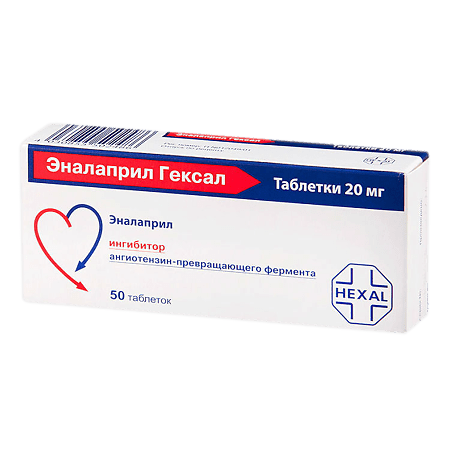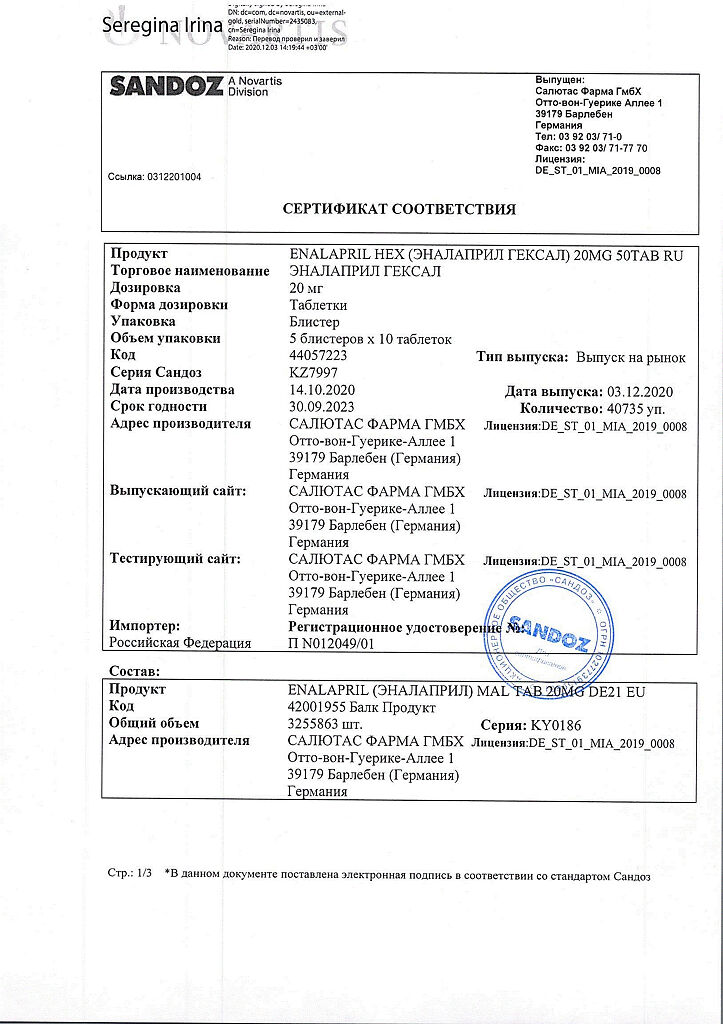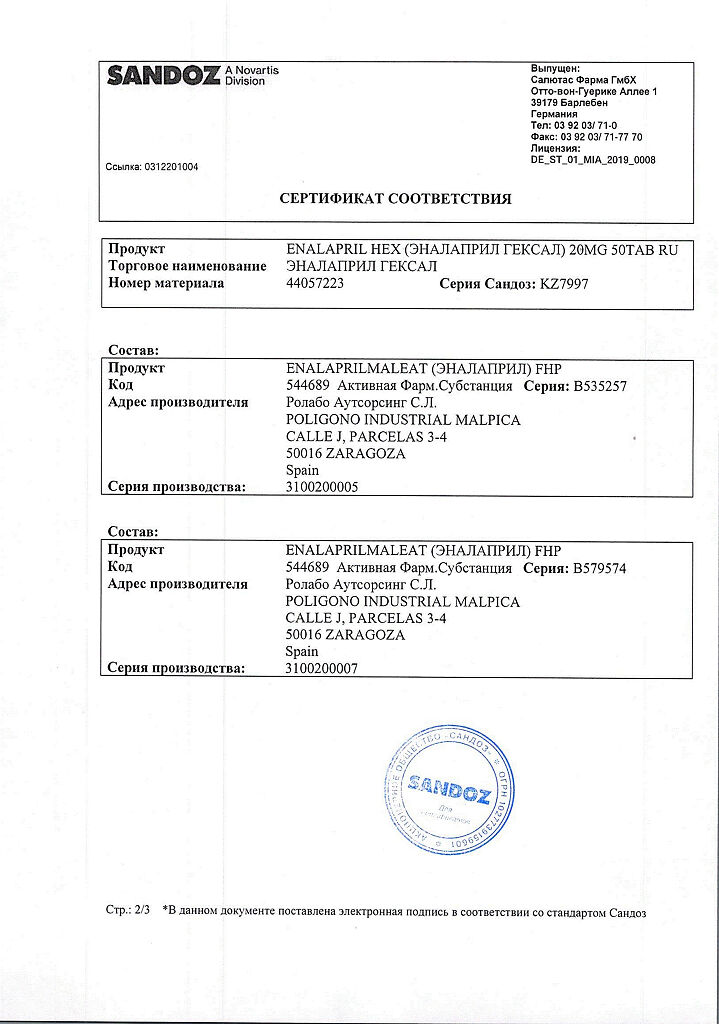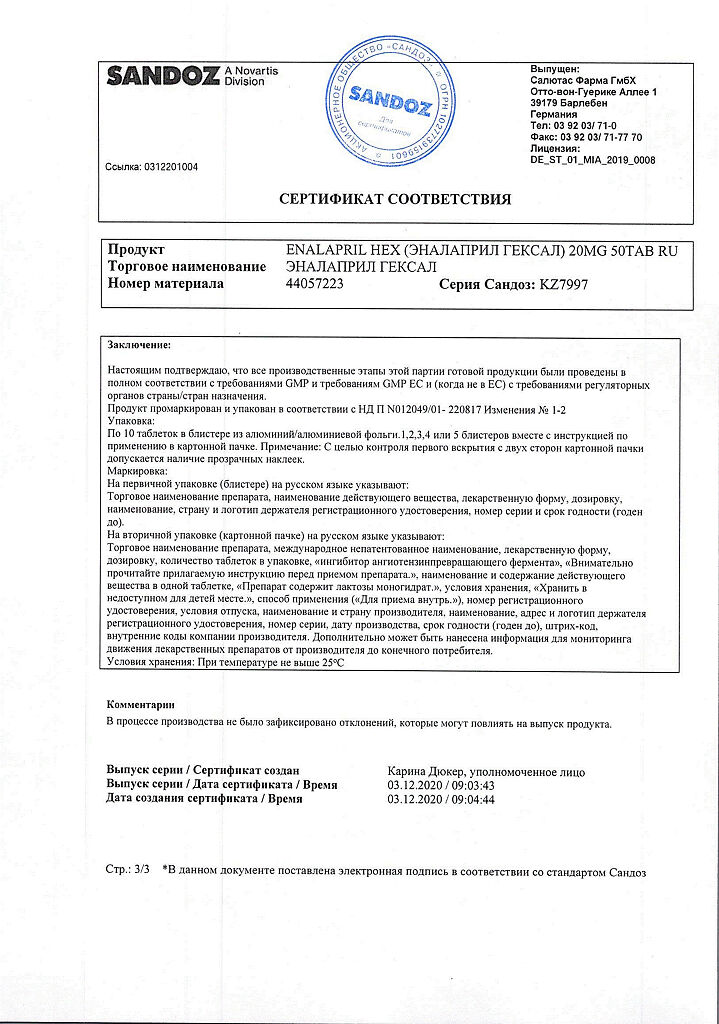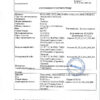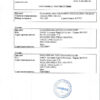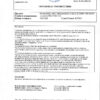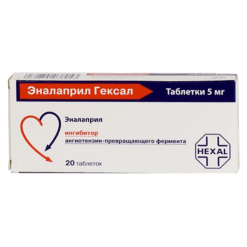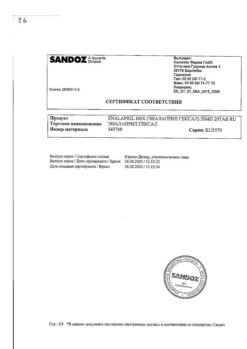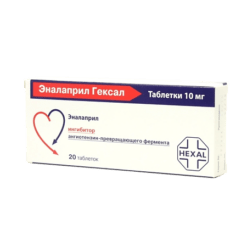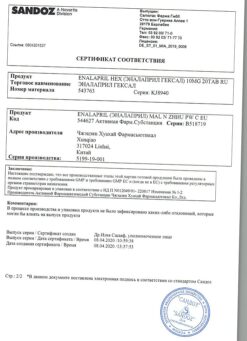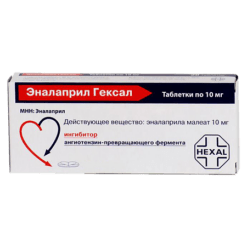No products in the cart.
Enalapril Hexal, tablets 20 mg 50 pcs
€6.48 €5.76
Description
ATC code: C09AA02
Pharmacological properties
Pharmacodynamics
. Enalapril is an angiotensin-converting enzyme (ACE) inhibitor used to treat arterial hypertension, heart failure, and diabetic nephropathy. The clinical effect of enalapril is due to inhibition of ACE activity and, as a consequence, reduction of angiotensin II formation from angiotensin I in tissues and circulating blood. Reducing the concentration of angiotensin II, in turn, leads to vasodilation, decreased secretion of aldosterone, increased potassium and plasma renin concentration.
Hemodynamic consequences of these changes are decreased total peripheral vascular resistance (TPR), systolic and diastolic blood pressure, increased cardiac output, and decreased post- and preload on the myocardium. Enalapril dilates arteries more than veins, and there is no reflex increase in heart rate (HR). It reduces bradykinin degradation and increases prostaglandin synthesis. Antihypertensive effect is more pronounced at high concentration of renin than at normal or reduced levels. Time of onset of antihypertensive effect when taken orally is 1 hour, which reaches a maximum after 4-6 hours and lasts up to 24 hours.
In some patients, therapy for several weeks is necessary to achieve optimal blood pressure (BP). In chronic heart failure noticeable clinical effect is observed with long-term treatment – 6 months or more. The duration of therapeutic effect is dose-dependent.
Vasodilating and some diuretic effect of enalapril are also provided by blockade of bradykinin destruction which in turn stimulates synthesis of vasodilatory and renal prostaglandins. Increased bradykinin both in blood plasma and locally in organs and tissues of the body blocks the pathological processes occurring in chronic heart failure in the myocardium, kidneys, vascular smooth muscle. At the same time there is an increase in coronary and renal blood flow, with prolonged use (3-4 weeks of treatment) left ventricular hypertrophy and myofibrils of arterial walls are reduced, left ventricular dilatation slows down and blood supply to ischemic myocardium is improved, metabolism improves and the frequency of arrhythmias after restoration of blood supply to the heart muscle decreases.
Due to moderate diuretic effect of the drug, intraclavian hypertension decreases, the development of glomerulosclerosis slows down and the risk of chronic renal failure decreases.
The decrease of BP within therapeutic limits (not lower than 110/60 mm Hg) does not affect the cerebral blood flow: the blood supply to the brain is maintained at the appropriate level even against the background of reduced BP.
The abrupt withdrawal of the treatment does not lead to the withdrawal syndrome (sharp rise in BP).
Enalapril does not cause metabolic disorders, does not affect glucose metabolism, does not increase the concentration of uric acid, does not change the profile of blood lipoproteins. Enalapril may decrease hypokalemic effect of thiazide diuretics.
Pharmacokinetics
Absorption
. When administered orally, enalapril is rapidly absorbed, the maximum concentration in blood plasma is reached within 1 hour.
Enalapril is well absorbed from the gastrointestinal tract (GIT), within 1 h (maximum 4-8 h) after oral administration the therapeutic effect is achieved. Food intake does not affect the absorption of the drug.
Distribution
In patients with normal renal function the equilibrium concentration of enalapril in plasma is reached on 2-3 days after the beginning of administration. It does not cumulate. Plasma protein binding is about 50%.
Elimination
Undergoes biotransformation in the liver to form the active metabolite – enalaprilat, the maximum concentration of which is determined 4 hours after intake. Excretion of enalapril is mainly through the kidneys – 60% (20% – as enalapril and 40% – as enalaprilat), through the intestine – 33% (6% – as enalapril and 27% – as enalaprilat). The elimination half-life (T1/2) is 11 hours.
In patients with a creatinine clearance (CK) less than 30 ml/min, the T1/2 of enalapril is increased. Reduced renal secretion of enalapril may increase hydrolysis to enalaprilate and increase extrarenal excretion of the drug.
The rate of hydrolysis of enalapril may be reduced in patients with impaired hepatic function without decreased therapeutic effect.
Passes through the placental barrier. It is excreted with breast milk. Virtually does not penetrate the blood-brain barrier. Does not accumulate in any tissues and organs.
Indications
Indications
arterial hypertension;
chronic heart failure (as part of combination therapy);
prevention of the development of clinically significant heart failure in patients with asymptomatic dysfunction of the left ventricle (as part of combination therapy).
Pharmacological effect
Pharmacological effect
ATX code: C09AA02
Pharmacological properties
Pharmacodynamics
Enalapril is an angiotensin-converting enzyme (ACE) inhibitor used to treat arterial hypertension, heart failure, and diabetic nephropathy. The clinical effect of enalapril is due to the suppression of ACE activity and, as a consequence, a decrease in the formation of angiotensin II from angiotensin I in tissues and circulating blood. A decrease in the concentration of angiotensin II, in turn, leads to vasodilation, a decrease in aldosterone secretion, an increase in potassium content and renin concentration in the blood plasma.
The hemodynamic consequences of these changes are a decrease in total peripheral vascular resistance (TPVR), systolic and diastolic blood pressure, an increase in cardiac output, and a decrease in post- and preload on the myocardium. Enalapril dilates arteries more than veins, and there is no reflex increase in heart rate (HR). Reduces the degradation of bradykinin, increases the synthesis of prostaglandins. The antihypertensive effect is more pronounced at high renin concentrations than at normal or reduced levels. The onset of the antihypertensive effect when taken orally is 1 hour, which reaches a maximum after 4-6 hours and lasts up to 24 hours.
In some patients, therapy over several weeks is necessary to achieve optimal blood pressure (BP). In chronic heart failure, a noticeable clinical effect is observed with long-term treatment – 6 months or more. The duration of the therapeutic effect is dose-dependent.
The vasodilating and some diuretic effect of enalapril is also provided by blockade of the destruction of bradykinin, which, in turn, stimulates the synthesis of vasodilating and renal prostaglandins. An increase in the content of bradykinin both in the blood plasma and locally in the organs and tissues of the body blocks the pathological processes that occur in chronic heart failure in the myocardium, kidneys, and vascular smooth muscles. In this case, an increase in coronary and renal blood flow is observed, with long-term use (from 3-4 weeks of treatment), hypertrophy of the left ventricle and myofibrils of the walls of resistive arteries decreases, dilation of the left ventricle slows down and blood supply to the ischemic myocardium improves, metabolism improves and the incidence of arrhythmias observed after restoration of blood supply to the heart muscle decreases.
Due to the moderate diuretic effect of the drug, intraglomerular hypertension is reduced, the development of glomerulosclerosis is slowed down and the risk of chronic renal failure is reduced.
A decrease in blood pressure within therapeutic limits (not lower than 110/60 mm Hg) does not affect cerebral circulation: blood flow to the brain is maintained at the proper level even against the background of reduced blood pressure.
Sudden cessation of treatment does not lead to withdrawal syndrome (a sharp rise in blood pressure).
Enalapril does not cause metabolic disorders, does not affect glucose metabolism, does not increase the concentration of uric acid, and does not change the blood lipoprotein profile. Enalapril may reduce the hypokalemic effect of thiazide diuretics.
Pharmacokinetics
Suction
When taken orally, enalapril is rapidly absorbed, the maximum concentration in the blood plasma is achieved within 1 hour.
Enalapril is well absorbed from the gastrointestinal tract (GIT), and a therapeutic effect is achieved within 1 hour (maximum 4-8 hours) after oral administration. Eating does not affect the absorption of the drug.
Distribution
In patients with normal renal function, the equilibrium concentration of enalapril in the blood plasma is achieved 2-3 days after the start of administration. Does not cumulate. Communication with blood plasma proteins is about 50%.
Removal
It undergoes biotransformation in the liver with the formation of an active metabolite – enalaprilat, the maximum concentration of which is determined 4 hours after administration. Excretion of enalapril is carried out mainly through the kidneys – 60% (20% – in the form of enalapril and 40% – in the form of enalaprilat), through the intestines – 33% (6% – in the form of enalapril and 27% – in the form of enalaprilat). The half-life (T1/2) is 11 hours.
In patients with creatinine clearance (CC) less than 30 ml/min, T1/2 of enalapril increases. Decreased renal secretion of enalapril may increase hydrolysis to enalaprilat and increase extrarenal excretion of the drug.
The rate of hydrolysis of enalapril may be reduced in patients with impaired liver function without reducing the therapeutic effect.
Penetrates through the placental barrier. Excreted in breast milk. Practically does not penetrate the blood-brain barrier. Does not accumulate in any tissues or organs.
Special instructions
Special instructions
During treatment, it is necessary to regularly monitor blood pressure, heart rate and electrocardiogram, clinical blood test, potassium, creatinine, urea, liver enzyme activity in the blood plasma, and protein content in the urine.
Caution must be exercised when prescribing to patients with a reduced circulating blood volume (as a result of diuretic therapy, limiting salt intake, hemodialysis, diarrhea and vomiting) – there is an increased risk of a sudden and pronounced decrease in blood pressure after using even the initial dose of Enalapril Hexal. Transient arterial hypotension is not a contraindication for continuing treatment with Enalapril Hexal after stabilization of blood pressure. In case of a repeated pronounced decrease in blood pressure, the dose should be reduced or the drug discontinued.
If an excessive decrease in blood pressure develops, the patient is transferred to the “lying” position with a low head, and, if necessary, a 0.9% sodium chloride solution and plasma-substituting drugs are administered.
The use of high-flow dialysis membranes (including AN69®) increases the risk of developing an anaphylactic reaction. Adjustment of the dosage regimen on days free from dialysis should be carried out depending on blood pressure.
Patients receiving ACE inhibitors during low-density lipoprotein (LDL) apheresis with dextran sulfate have rarely experienced anaphylactoid reactions. Therefore, this method should not be used in patients receiving ACE inhibitors.
Patients with decompensated chronic heart failure, coronary heart disease, and cerebrovascular diseases, in whom a sharp decrease in blood pressure can lead to myocardial infarction, stroke, or impaired renal function, should be carefully monitored.
Sudden cessation of treatment does not lead to withdrawal syndrome (a sharp rise in blood pressure).
In patients with coronary heart disease or cerebrovascular insufficiency, treatment should begin with low doses of the drug.
It should be taken into account that for patients with diabetes mellitus with normoalbuminuria, Enalapril Hexal is prescribed only after determining the functional renal reserve; for micro- and macroalbuminuria – without prior determination. In patients with reduced renal function, the single dose should be reduced or the intervals between doses should be increased. In patients with diabetes mellitus, it is necessary to regularly monitor the concentration of glucose in the blood, especially against the background of hypokalemia.
During treatment with Enalapril Hexal, an increase in potassium levels in the blood serum is possible, especially in patients with chronic renal failure, diabetes mellitus, while prescribing potassium-sparing diuretics (spironolactone, eplerenone, triamterene, amiloride is not recommended) or potassium supplements. Such patients should be informed of the need to consult a doctor if muscle weakness and arrhythmia occur.
When using ACE inhibitors, a dry cough may develop. Coughing attacks are persistent, but quickly disappear after discontinuation of the drug. This feature should be taken into account in the differential diagnosis of cough. If necessary, treatment can be continued.
During the period of desensitization to wasp or bee venom, patients receiving the drug Enalapril Hexal may develop a hypersensitivity reaction. To avoid such reactions, it is recommended to temporarily discontinue treatment with ACE inhibitors before each desensitization procedure.
Before surgery (including dentistry), you must warn the surgeon/anesthesiologist about the use of Enalapril Hexal.
In rare cases, during the use of ACE inhibitors, cholestatic jaundice occurs, with the progression of which fulminant liver necrosis develops, sometimes with a fatal outcome. If jaundice occurs and the activity of liver transaminases increases while using the drug Enalapril Hexal, treatment should be discontinued. Cases of neutropenia/agranulocytosis, thrombocytopenia and anemia have been reported in patients taking ACE inhibitors.
In patients with normal renal function in the absence of other complications, neutropenia rarely develops. Enalapril Hexal should be used with great caution in patients with connective tissue diseases (including systemic lupus erythematosus, scleroderma) who are simultaneously receiving immunosuppressive therapy, allopurinol or procainamide, as well as a combination of these factors, especially with existing renal dysfunction. These patients may develop severe infections that do not respond to intensive antibiotic therapy.
If patients still take Enalapril Hexal, it is recommended to periodically monitor leukocytes in the blood. The patient should be warned that if any signs of infection appear, they should consult a doctor. If angioedema of the face occurs, it is usually sufficient to discontinue therapy and prescribe antihistamines to the patient.
Angioedema of the tongue, pharynx or larynx can be fatal. In case of angioedema of the tongue, pharynx or larynx, which can lead to airway obstruction, it is necessary to immediately administer epinephrine (0.3-0.5 ml of epinephrine (adrenaline) solution subcutaneously in a ratio of 1:1000) and maintain airway patency (intubation or tracheostomy).
Among black patients receiving ACE inhibitor therapy, the incidence of angioedema is higher than among patients of other races. Patients with a history of angioedema not associated with the use of ACE inhibitors are at increased risk of developing angioedema when taking any ACE inhibitor.
There is no experience with the use of the drug in patients after kidney transplantation, therefore treatment with Enalapril Hexal is not recommended in patients after kidney transplantation.
Impact on the ability to drive vehicles and machinery
When taking the drug Enalapril Hexal, caution should be exercised when driving vehicles and engaging in potentially hazardous activities that require increased concentration and speed of psychomotor reactions.
Active ingredient
Active ingredient
Enalapril
Composition
Composition
1 tablet contains:
active substance:
enalapril malealate 5.0 mg/10.0 mg/20.0 mg;
excipients:
sodium bicarbonate 2.6 mg/5.1 mg/10.2 mg;
lactose monohydrate 129.8 mg/124.6 mg/117.8 mg;
corn starch 22.4 mg/21.4 mg/13.9 mg;
talc 6.0 mg/6.0 mg/6.0 mg;
hyprolose 2.5 mg/-/-;
magnesium stearate 1.7 mg/1.7 mg/1.7 mg;
iron oxide red -/1.2 mg/0.1 mg;
iron oxide yellow -/-/0.3 mg.
Contraindications
Contraindications
• hypersensitivity to enalapril and other ACE inhibitors, as well as to any other component of the drug;
• lactose intolerance, lactase deficiency, glucose-galactose malabsorption syndrome;
• history of angioedema associated with previous use of ACE inhibitors, hereditary angioedema or idiopathic angioedema;
• simultaneous use of enalapril and aliskiren in patients with diabetes mellitus or renal failure (creatinine clearance less than 60 ml/min);
• age under 18 years (efficacy and safety have not been established);
• pregnancy.
• breastfeeding period.
Enalapril Hexal should be used with caution in patients with bilateral renal artery stenosis or stenosis of the artery of a single kidney, primary hyperaldosteronism, hyperkalemia, or conditions after kidney transplantation; cerebrovascular diseases (including cerebrovascular insufficiency); coronary heart disease (CHD), recent myocardial infarction (up to 3 months); chronic heart failure, aortic and/or mitral stenosis (with impaired hemodynamic parameters), hypertrophic obstructive cardiomyopathy; hypovolemic state (associated with long-term use of diuretics, the presence of a salt-restricted diet, diarrhea or vomiting, hemodialysis, after surgery); severe autoimmune systemic connective tissue diseases (including scleroderma, systemic lupus erythematosus); with suppression of bone marrow hematopoiesis; with liver failure; in old age (over 65 years); for diabetes mellitus; with renal failure (proteinuria – more than 1 g/day); when used simultaneously with immunosuppressants and diuretics; in patients undergoing dialysis using high-flux membranes (such as AN69®); during desensitization; in patients of the Negroid race; with low-density lipoprotein apheresis.
Side Effects
Side Effects
According to the World Health Organization (WHO), adverse effects are classified according to their frequency as follows: very common (≥1/10), common (≥1/100 to <1/10), uncommon (≥1/1,000 to <1/100), rare (≥1/10,000 to <1/1,000), very rare (< 1/10,000); frequency unknown - based on available data, it was not possible to determine the frequency of occurrence.
From the cardiovascular system
very often: dizziness;
often: marked decrease in blood pressure (including orthostatic), syncope, chest pain, arrhythmia, tachycardia, angina pectoris;
uncommon: palpitations, myocardial infarction, stroke, incl. secondary after the development of severe hypotension;
rarely: thromboembolism of a branch of the pulmonary artery, Raynaud’s syndrome.
From the central nervous system
often: headache, depression;
uncommon: dizziness, drowsiness, insomnia, increased excitability, confusion, paresthesia, vertigo;
rare: unusual dreams, sleep disturbance.
From the respiratory system
very often: cough;
often: shortness of breath;
uncommon: rhinorrhea, sore throat, hoarseness, bronchospasm (bronchial asthma);
rarely: pulmonary infiltration, rhinitis, allergic alveolitis (eosinophilic pneumonia).
From the digestive system
very often: nausea;
often: diarrhea, abdominal pain, disturbance of taste;
uncommon: intestinal obstruction, pancreatitis, vomiting, dyspepsia, constipation, anorexia, peptic ulcer, dry oral mucosa, irritable bowel syndrome;
rarely: stomatitis/aphthous ulcers, glossitis, liver failure, hepatitis (including liver necrosis), cholestasis, jaundice, increased activity of liver transaminases and bilirubin in the blood plasma;
very rare: intestinal angioedema.
From the genitourinary system
uncommon: renal dysfunction, renal failure, proteinuria, impotence, increased urea concentration in blood plasma;
rarely: oliguria, gynecomastia.
From the side of the organ of vision
very common: visual impairment.
From the hematopoietic and lymphatic systems
uncommon: anemia (including aplastic, hemolytic);
rarely: neutropenia, thrombocytopenia, agranulocytosis, inhibition of bone marrow hematopoiesis, pancytopenia, decreased hemoglobin, decreased hematocrit, lymphadenopathy, autoimmune diseases.
From the endocrine system
frequency unknown: syndrome of inappropriate secretion of antidiuretic hormone.
Allergic reactions
often: urticaria, skin rash, exanthema, hypersensitivity reactions/angioedema (angioedema of the face, extremities, lips, tongue, pharynx and/or larynx has been described);
uncommon: increased sweating, itching, urticaria, alopecia;
rarely: erythema multiforme, Stevens-Johnson syndrome, toxic epidermal necrolysis (Lyell’s syndrome), exfoliative dermatitis, pemphigus, erythroderma.
A symptom complex has been described that may include fever, myalgia and arthralgia, serositis, vasculitis, increased erythrocyte sedimentation rate, leukocytosis and eosinophilia, skin rash, and a positive test for antinuclear antibodies. A symptom complex has also been described, which includes facial skin flushing, nausea, vomiting and arterial hypotension and can develop with the simultaneous use of ACE inhibitors and gold preparations (sodium aurothiomalate) intravenously.
Other
very often: asthenia;
often: increased fatigue, hyperkalemia, increased creatinine concentration in the blood;
uncommon: muscle twitching, tinnitus (tinnitus), hyperemia (redness of the skin), malaise, fever, dysphonia, hypoglycemia, hyponatremia, increased blood urea concentration.
Interaction
Interaction
The simultaneous use of ACE inhibitors with other drugs acting on the renin-angiotensin-aldosterone system (RAAS) increases the risk of developing arterial hypotension, hyperkalemia and renal dysfunction (including acute renal failure).
As with other ACE inhibitors and angiotensin II receptor antagonists, the combined use of enalapril and aliskiren is contraindicated in patients with diabetes mellitus or renal failure (creatinine clearance less than 60 ml/min).
Mutual enhancement of action with simultaneous use of enalapril with other antihypertensive drugs.
Concomitant use with nitroglycerin or other nitrates, or other vasodilators, tricyclic antidepressants, antipsychotics, general anesthetics, narcotic drugs leads to increased antihypertensive effect.
With simultaneous use of enalapril with diuretics (thiazide or loop diuretics), the antihypertensive effect may be enhanced. The simultaneous use of enalapril and potassium-sparing diuretics (such as spironolactone, eplerenone, triamterene, amiloride), potassium supplements or potassium-containing table salt substitutes, as well as the use of other drugs that increase the level of potassium in the blood plasma (for example, heparin).
The simultaneous use of non-steroidal anti-inflammatory drugs (NSAIDs) (including selective cyclooxygenase-2 (COX-2) inhibitors) may weaken the antihypertensive effect of antihypertensive drugs due to an increase in potassium content in the blood plasma, which leads to reversible impairment of renal function and fluid retention. Therefore, the antihypertensive effect of angiotensin II receptor antagonists or ACE inhibitors may be attenuated by NSAIDs, including COX-2 inhibitors.
NSAIDs and ACE inhibitors have an additive effect on increasing serum potassium, which may lead to a deterioration of renal function, especially in patients with impaired renal function. This effect is reversible. Coadministration should be done with caution in patients with impaired renal function.
The simultaneous use of enalapril and lithium preparations is not recommended, since the concentration of lithium in the blood plasma increases and, accordingly, an increase in its toxic effects is observed. When using enalapril and lithium preparations simultaneously, it is necessary to monitor the concentration of lithium in the blood plasma.
Simultaneous use with thiazide diuretics leads to an increase in the concentration of lithium salts in the blood plasma.
With the simultaneous use of enalapril with gold preparations for parenteral administration (sodium aurothiomalate), a symptom complex may occur, including facial flushing, nausea, vomiting, and arterial hypotension.
Weakens the effect of drugs containing theophylline.
Concomitant use with insulin and oral hypoglycemic agents increases the risk of hypoglycemia.
Immunosuppressants, allopurinol, cytostatics increase hematotoxicity.
Medicines that cause bone marrow suppression increase the risk of developing neutropenia and/or agranulocytosis.
Ethanol enhances the antihypertensive effect of enalapril.
Enalapril can be used simultaneously with acetylsalicylic acid (as an antiplatelet agent), thrombolytics and β-blockers. Concomitant use with other ACE inhibitors may increase the risk of hyperkalemia. Antacids may reduce the bioavailability of ACE inhibitors. Sympathomimetics may reduce the antihypertensive effect of ACE inhibitors.
Overdose
Overdose
Symptoms: headache, marked decrease in blood pressure, up to the development of collapse, myocardial infarction, acute cerebrovascular accident or thromboembolic complications, convulsions, stupor, tachycardia, rapid heartbeat, dizziness, bradycardia, palpitations, renal failure, cough, anxiety.
Treatment: symptomatic. The patient is transferred to the “lying” position with a low headboard. In mild cases, gastric lavage and ingestion of activated charcoal are indicated; in more severe cases, measures aimed at stabilizing blood pressure are indicated: intravenous administration of a 0.9% sodium chloride solution, plasma expanders, connection of an artificial pacemaker for bradycardia resistant to drug therapy, hemodialysis (the elimination rate of enalapril is on average 62 ml/min).
Storage conditions
Storage conditions
List B. Store in a dry place, out of reach of children, at a temperature of 15 to 25°C.
Shelf life
Shelf life
3 years.
Manufacturer
Manufacturer
Salutas Pharma GmbH, Germany
Additional information
| Shelf life | 3 years. |
|---|---|
| Conditions of storage | List B. Store in a dry place out of reach of children at 15 to 25°C. |
| Manufacturer | Salutas Pharma GmbH, Germany |
| Medication form | pills |
| Brand | Salutas Pharma GmbH |
Other forms…
Related products
Buy Enalapril Hexal, tablets 20 mg 50 pcs with delivery to USA, UK, Europe and over 120 other countries.

